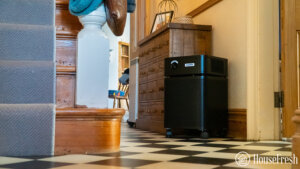Most air purifiers claim to clear large rooms, but for allergy sufferers, that’s often a dangerous lie.
In this article, I will dispel the biggest myths and share my advice on the only models you should consider, knowing they will do the job without sounding like a jet engine or cost an arm and a leg to run.
However, before I list the models to consider, let me outline the three key factors you should be aware of when selecting an air purifier for allergies.
1. Air changes per hour and room sizes
The most critical number for allergy sufferers is Air Changes Per Hour, or ACH.
ACH indicates how many times an air purifier can completely filter the air in a specific room within one hour.
Walk through Amazon, and you’ll see tiny purifiers claiming to clean 1,000 sq. ft. rooms, but they’re usually quoting that based on just ONE air change per hour. For your allergies? That’s like trying to empty a sinking boat with a teaspoon. Sure, it eventually cleans the old pollen, but in that same hour, a whole new batch of allergens will make their way into the room.
Industry experts at AHAM (that’s the Association of Home Appliance Manufacturers) say you need at least 4.8 ACH. For severe allergies? We recommend aiming for 6 ACH. Six air changes per hour means that the air in a room will be cleaned of all pollutants every 10 minutes.
This means that many small purifiers with a low Clean Air Delivery Rate (or CADR) aren’t up to the task for serious allergy relief.
Let’s take the popular Levoit Core Mini as an example: The Levoit Core Mini has a dust CADR of 41 CFM. We plug that into our HouseFresh CADR calculator for six ACH, and what do we get? A maximum room size of just 51 sq. ft.
That’s barely a walk-in closet, not your bedroom.
2. The importance of sound
But high ACH isn’t the only piece of the puzzle. If your purifier sounds like a 747 taking off, you won’t use it, especially at night when allergies can be the worst.
Let’s use the Molekule Air Mini+ as an example: At top speed, it has a PM1 CADR of 96 CFM, which could give you six ACH in a 120 sq. ft. room. The catch? It does this blasting out 67.4 decibels… That’s louder than a vacuum cleaner—try sleeping next to that! When we tested it at a more livable 45 dBA, the CADR plummeted to 36 CFM—that’s six ACH in a room smaller than what the tiny Levoit Core Mini could manage at its top speed.
3. Particle vs gas filtration
If you are allergic to pollen, dust, or pet dander, focus on finding a device with a high-quality particle filter.
Activated carbon filters are only necessary in cases where your allergies are tied to chemical sensitivities, where you need to remove triggers such as cigarette smoke, perfume, insecticide, new carpet smell, paint fumes, etc.
So, the magic formula for most allergy sufferers is six air changes per hour at under 45 decibels with a solid particle filter.
With that in mind, I have shortlisted four air purifier models that offer excellent value for allergy sufferers. I have spent the last five years testing over 100 air purifiers—if you want more details, check this article.
The best overall is the CleanAirKits Luggable XL-7
This PC fan-powered air purifier uses HVAC filters and has been a game changer in the world of air purifiers, thanks to its exceptional air cleaning performance at whisper-quiet operation.

The Luggable XL-7 uses seven Cooler Master SickleFlow 120 PC fans that pull the air through two 20×25 3M MERV 13 MPR1900 filters. This combination results in a dust CADR of 323 cfm with a max sound level of 38.8 dBA!
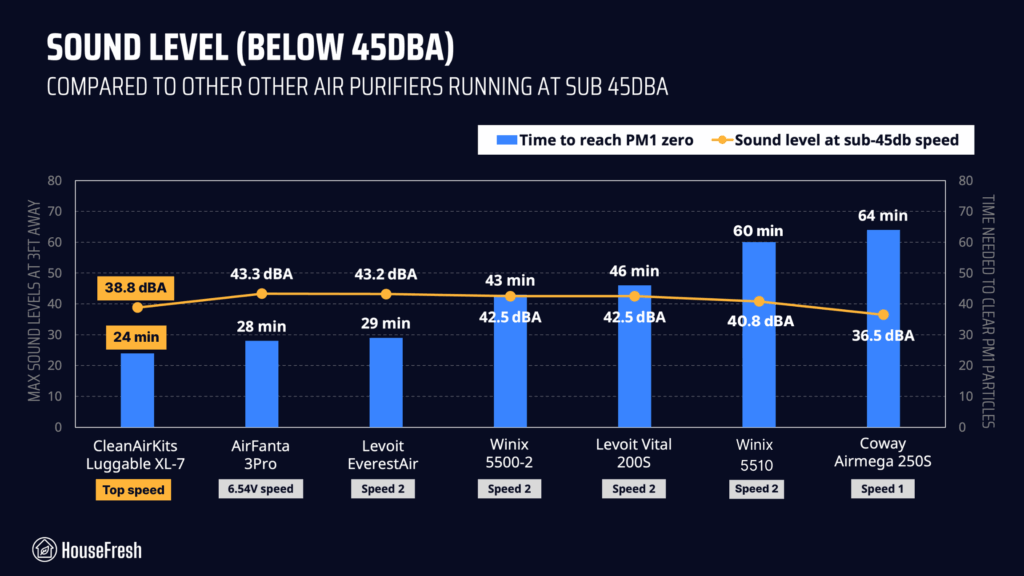
The Luggable XL-7 is the quietest high-CADR air purifier we have ever tested. It can provide six air changes per hour in rooms up to 403 square feet at whisper quiet operation.


It is energy-efficient and you can choose any 20×25 MERV 13 HVAC filters, but we recommend the 3M Filtrete MPR1900.
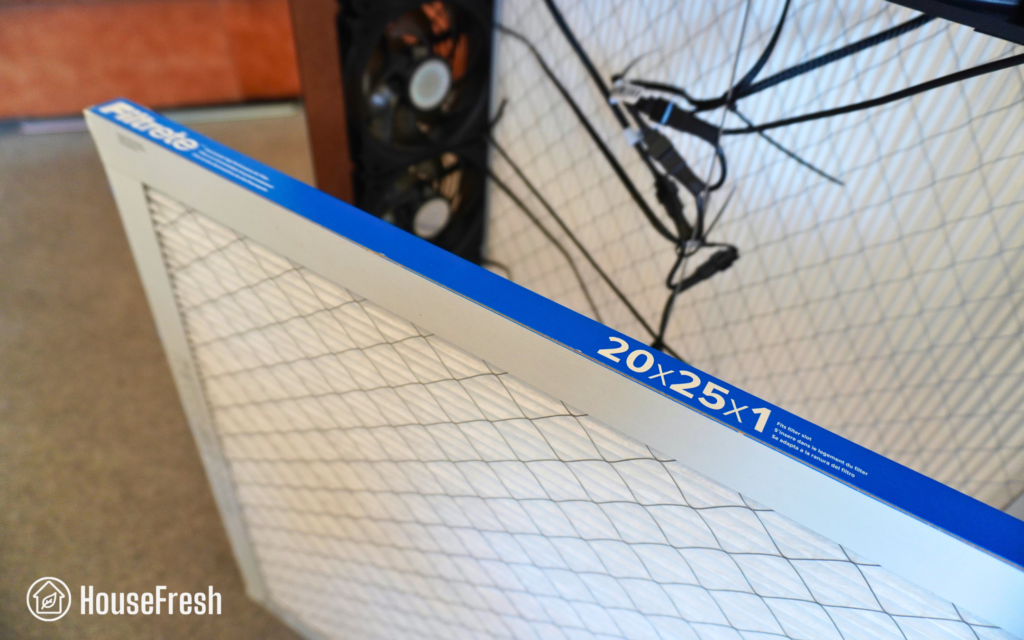
CONS
PROS
| Clean air delivery rate (CADR): | – Top speed PM1 CADR: 260 cfm – Sub-45 dBA PM1 CADR: 260 cfm – Intertek PM2.5: 323 cfm (dust) |
| Filter technology: | MERV 13 (20×25) |
| Recommended room size: | 390 sq. ft. (5 air changes per hour) |
| Dimensions: | 7D x 25W x 20H in (18D x 64W x 51 cm) |
| Weight: | 8 lbs (3.63 kg) |
| Noise level in decibels from 3 ft. away: | Only speed: 38.8 dBA |
| Electricity consumption in watts: | Only speed: 10.5 watts |
| Filter lifespan: | 6-12 months |
| Manufacturer’s warranty: | 1 year |
| Country of origin: | United States |
| Country of manufacture: | United States |
- For those in Canada, you will want to check out Northbox Systems. They are a Canadian team that produces PC fan-powered air purifiers that use HVAC filters locally. We tested the 6XL and its air cleaning performance is outstanding.
- For those in Europe, check out the Nukit Tempest Euro, which uses PC fans and IKEA Starkvind filters. But be aware that, unlike Northbox Systems and CleanAirKits devices, the Tempest Euro is only available as a DIY kit for you to build yourself.
The best under $200 is the AirFanta 3Pro
With a top speed CADR of 413 cfm and a low price of $159.99, there is a lot to like about the AirFanta 3Pro.

Use the discount code HOUSEFRESH for 5% off when buying directly from AirFanta.
With a top speed CADR of 413 cfm and a low price of $159.99, there is a lot to like about the AirFanta 3Pro. For those with allergies, the big benefit of this device is its excellent air cleaning performance at quiet sound levels.

The 3Pro is a small box with a base at the bottom, one filter at each side, and a PC fan array on top—making a much compact version of the bulky Corsi-Rosenthal box (left).
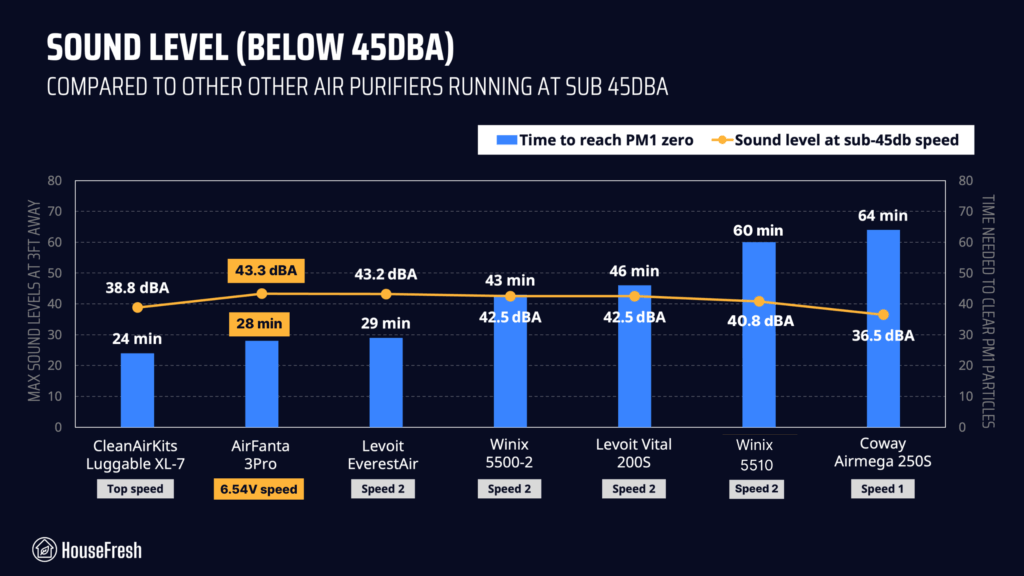
In testing, we identified a fan speed that generates less than 45 dBA (6.54 V) and has an estimated CADR PM1 of 213 cfm, which is higher than what we saw with the much larger (and much more expensive) Levoit EverestAir.
CONS
PROS
Another feature to highlight is that the 3Pro is the only high CADR air purifier that fits inside a backpack. This device can be disassembled and reassembled in just a few minutes, so could be a great solution for those wanting to have protection from allergens when traveling to a new place.



| Clean air delivery rate (CADR): | – Top speed PM1 CADR: 353 cfm – Sub-45 dBA PM1 CADR: 213 cfm |
| Filter technology: | True HEPA H11 and optional pelleted activated carbon |
| Recommended room size: | 529 sq. ft. (5 air changes per hour) |
| Dimensions: | 12.6D x 12.6W x 12.6H inches (32D x 32W X 32H cm) |
| Weight: | 7.7 lbs (3.49 kg) |
| Noise level in decibels from 3 ft. away: | 3.63 volts: 36.1 dB 4.19 volts: 36.9 dB 5.24 volts: 39.7 dB 6.54 volts: 43.3 dB 7.44 volts: 46.7 dB 8.56 volts: 49.1 dB 12.6 volts: 56.3 dB |
| Electricity consumption in watts : | 43.23 watts |
| Filter lifespan: | 6 – 12 months |
| Manufacturer’s warranty: | 1 year |
| Country of origin: | China |
| Country of manufacture: | China |
The best for large spaces is the Coway Airmega ProX
If the DIY look isn’t for you and you need serious power to clean the air in a large space, then look no further than the ProX.
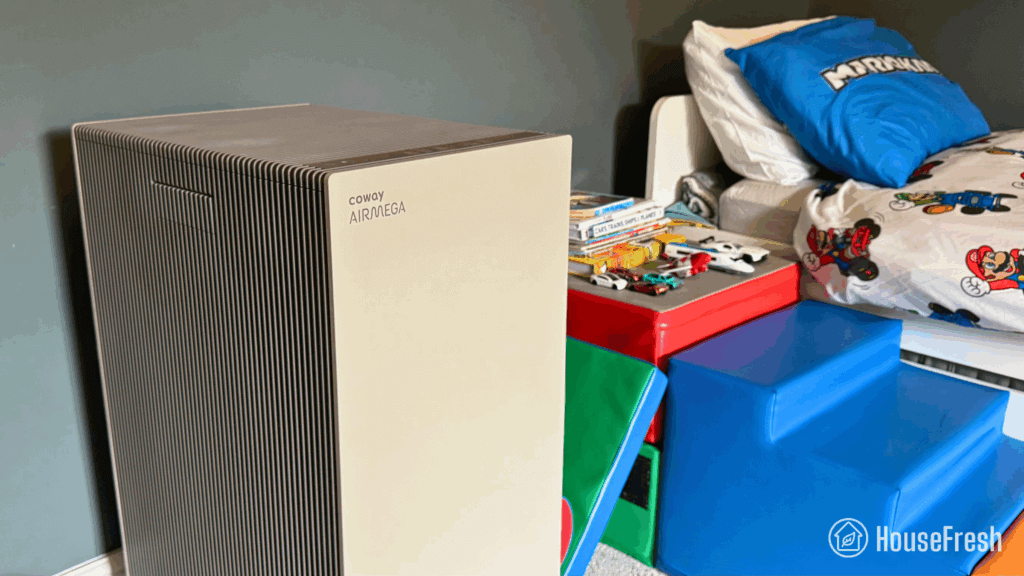
With an estimated PM1 CADR of 299 cfm at sub-45 dBA fan speeds, the Coway Airmega ProX can provide 6 air changes per hour in spaces up to 373 square feet.
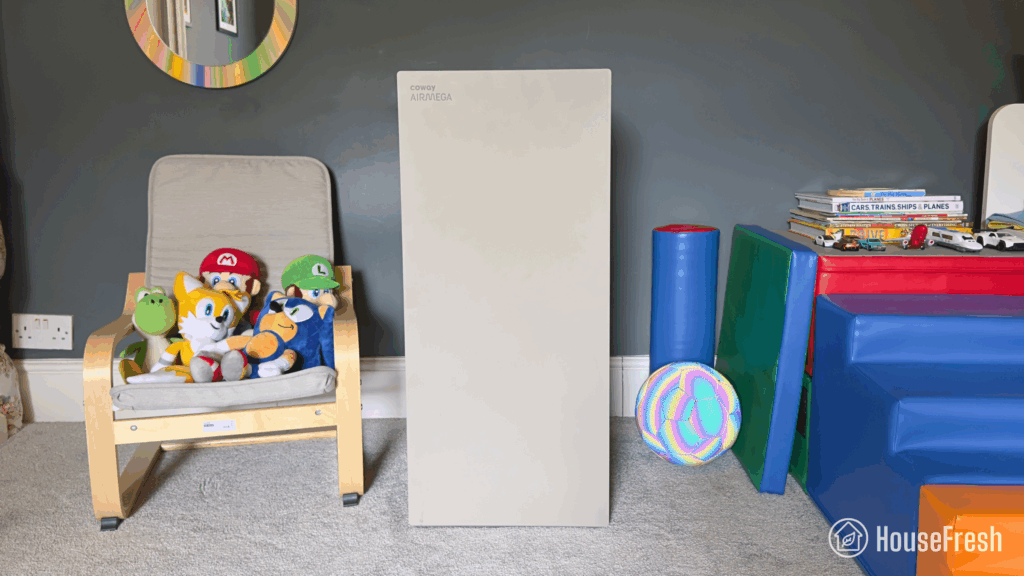
We estimate a PM1 CADR of 462 cfm at full speed, which would give you 6 air changes per hour in rooms as large as 577 square feet.
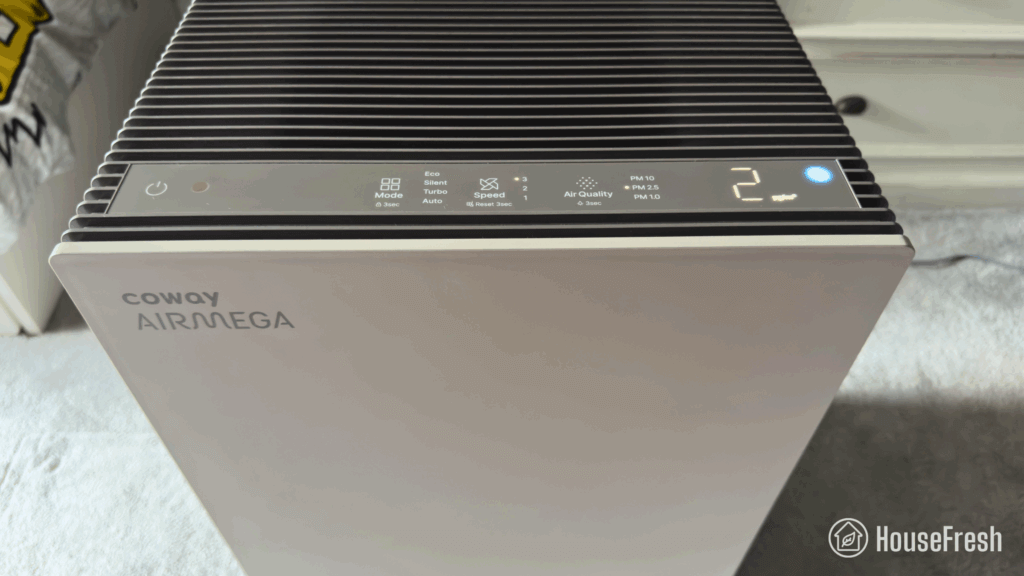
Unlike the rest of the air purifiers on this list, the Airmega ProX comes with an onboard air quality sensor so it can react to changes of pollutants in the air when running on auto mode.
CONS
PROS
| Clean air delivery rate (CADR): | – Top speed PM1 CADR: 462 cfm – Sub-45 dBA PM1 CADR: 299 cfm – AHAM PM2.5 CADR: 586 cfm (dust) |
| Filter technology: | Green True HEPA filter with pelleted activated carbon |
| Recommended room size: | 693 sq. ft. (5 air changes per hour) |
| Dimensions: | 18.9 x 36.6 x 24.3 in (48 x 93 x 62 cm) |
| Weight: | 51 lbs (23kg) |
| Noise level in decibels from 3 ft. away: | Speed 1: 37.4 dBA Speed 2: 44.4 dBA Speed 3: 53.6 dBA |
| Electricity consumption in watts: | Standby: 0 watts Speed 1: 11.76 watts Speed 2: 26.09 watts Speed 3: 58.88 watts |
| Filter lifespan: | 12 months |
| Manufacturer’s warranty: | 3 years |
| Country of origin: | South Korea |
| Country of manufacture: | South Korea |
The best for small spaces is the Smart Air SA600
The SA600 is a mid-sized air purifier from Smart Air that will give you six air changes per hour in rooms up to 160 sq. ft.

When running at speed 3, the SA600 generates just 41.5 dBA and based on our particle removal test, we estimated a PM1 CADR of 128 cfm, which is good enough for six air changes in spaces up to 160 square feet.

The SA600 uses two sets of non-bonded filters: two H13 HEPA filters, two pelleted carbon filters and two pre-filters.
If your allergies are not triggered by VOCs, you can run it without the activated carbon filters to reduce long-term costs.

The SA600 doesn’t come with an on-board sensor, auto-mode and app connectivity.
But this can actually be a pro as you can just set it at speed 3 (41.5 dBA) and forget about it until the time comes to replace the HEPA filters.
PROS
CONS
| Clean air delivery rate (CADR): | – Top speed PM1 CADR: 249 cfm – Sub-45 dBA PM1 CADR: 128 cfm – AHAM PM2.5 CADR: 287 cfm (dust) |
| Filter technology: | H13 TrueHEPA filter with a removable pre-filter and pelleted activated charcoal filter (set of two) |
| Recommended room size: | 373 sq. ft. (5 air changes per hour) |
| Dimensions: | 20 x 13.8 x 9 inches (51 x 35 x 23 cm) |
| Weight: | 15.5 lbs (7 kg) |
| Noise level in decibels from 3 ft. away: | Speed 1: 35.2 dBA Speed 2: 37.2 dBA Speed 3: 41.5 dBA Speed 4: 46.1 dBA Speed 5: 56.7 dBA |
| Electricity consumption in watts: | Standby: 0.1 watts Speed 1: 2.4 watts Speed 2: 4.3 watts Speed 3: 7.1 watts Speed 4: 12.9 watts Speed 5: 53.8 watts |
| Filter lifespan: | HEPA: 8 months Carbon: 4 months |
| Manufacturer’s warranty: | 1 year |
| Country of origin: | China |
| Country of manufacture: | China |
Some notable mentions
These seven air purifiers were very close to making this list. Depending on your budget and availability in your location, it could be worth checking them out.

Smart Air Blast Mini MKII
It has a PM1 CADR of 400 cfm at top speed (56.3 dBA) and 272 cfm at speed 1 (44.9 dBA). It comes with optional carbon, so if your allergies are triggered by particles, you can stick to HEPA H13 only. It didn’t make the list because the ProX offers better performance at a quieter level (299 cfm at 44.4 dBA) and has a sensor.
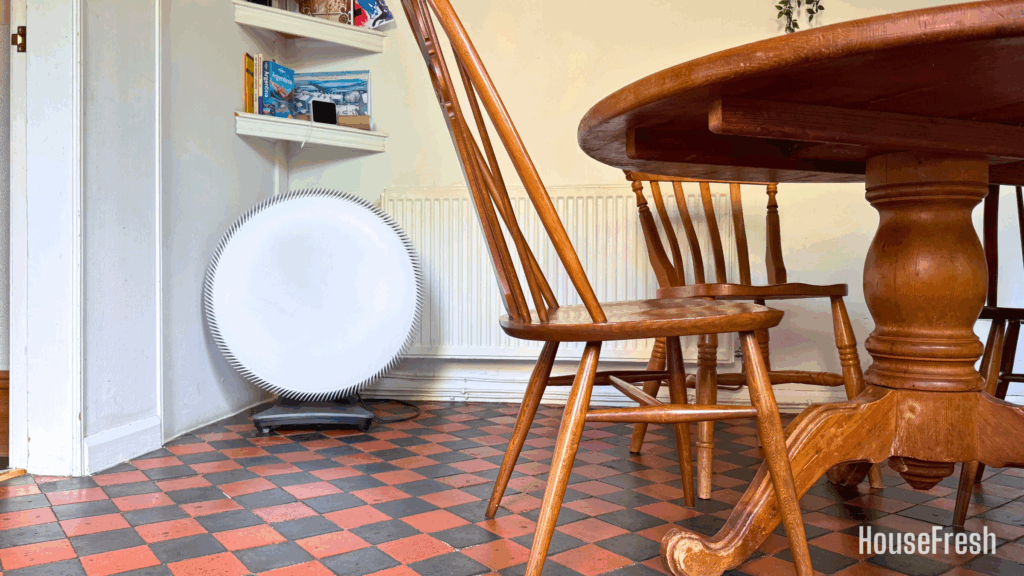
IQAir Atem X
At top speed (62.3 dBA), we estimate a PM1 CADR of 429 cfm and at speed 4 (44.5 DBA) we estimate 229 cfm, which would be good enough for rooms up to 286 sq. ft. I didn’t shortlist the Atem X due to its high price tag ($1,399.99), which makes it hard to recommend over the $800 Airmega ProX.
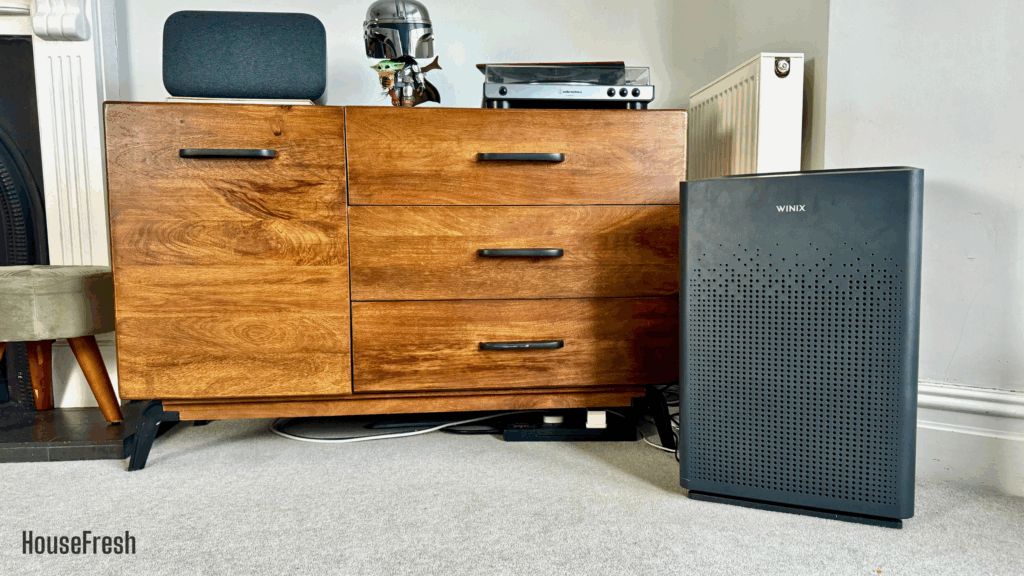
Winix AM80 (or Zero S)
It can be regularly found for $190 and will deliver 134 cfm at speed 3 (43.3 dBA), which is good for 6 ACH in spaces no larger than 167 sq. ft. It is no match for the cheaper AirFanta 3Pro, but it could be a good alternative to the Smart Air SA600.

Levoit Vital 200S
This is a solid performer under $200 with app support, smart functions and a sensor. It didn’t make the list because its raw air cleaning power at top speed (260 cfm at 57.7 dBA) is not nearly as good as what you’ll get with the AirFanta 3Pro (353 cfm at 56.3 dBA).

Dyson Big+Quiet BP06
This is not only the cheapest Dyson’s Big+Quiet model ($899.99) but also the best-performing Dyson purifier we tested. It will give you 198 cfm at top speed (51.4 dbA) and 128 cfm at speed 1 (40.4 dBA), which makes it good enough for rooms up to 160 sq. ft. However, its performance is comparable to models that cost a third of its price.

Coway Airmega 200M / Coway Airmega AP-1512hh
The 200M and the AP-1512hh are two popular Coway Airmega models recommended by big media sites. The 200M offers 118 cfm at speed 1 (36.9 dBA) and the AP-1512hh provides 115 cfm at speed 2 (44.4 dBA), making both of them suitable for rooms no larger than 144 sq. ft. Sadly, they are both noisy at top speeds (<60 dBA) and too underpowered at sub-45 dB fan speeds.
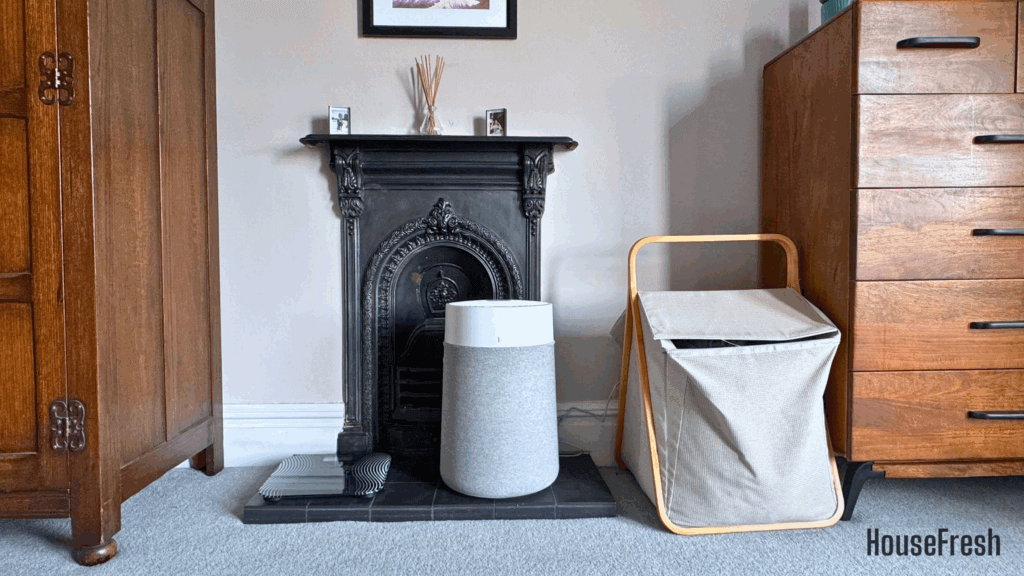
Blueair Blue Pure 311i Max
It can usually be found for less than $200 and offers good performance with a PM1 CADR of 220 cfm at top speed (57.7 dBA) and a CADR of 108 cfm at speed 1 (37 dBA) that can provide 6 ACH in spaces up to 135 sq. ft. However, you will be forced to use an ionization process (HEPASilent), as this feature cannot be disabled unlike what we see in models from Winix, Coway and Alen.
Wrapping up
So there you have it, four excellent air purifiers that will actually offer solid particle removal performance and good value for allergy sufferers. If you are unsure of which one to get, feel free to drop me an email to danny@housefresh.com and I can help you find the best option for your specific situation.
I hope you found my guide useful, and if you decide to buy any of the air purifiers I mentioned today, please use the links in the buttons to help support the work we do here at HouseFresh. It won’t cost you anything extra and we will get a small affiliate commission that will allow us to keep buying and testing air purifiers in the future.
Do you have any questions about air filters for allergies that I haven’t answered? Leave them in the comments below and I’ll get back to you as soon as I can.



